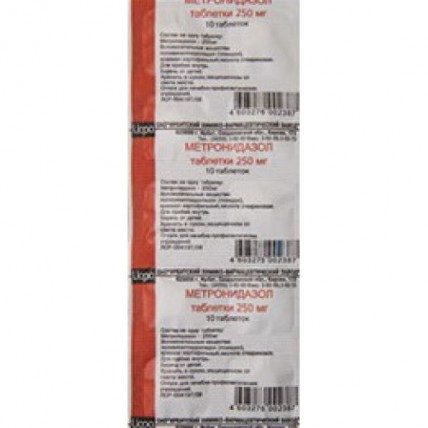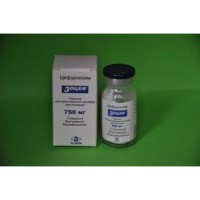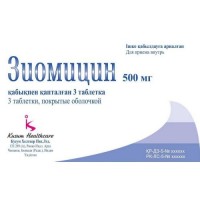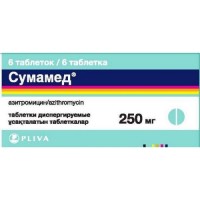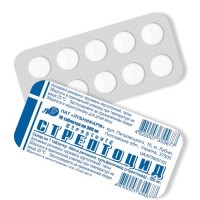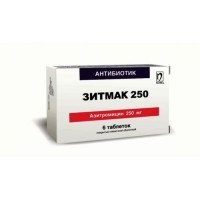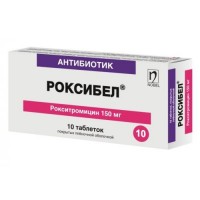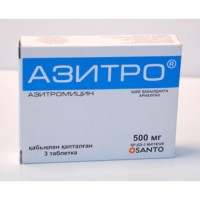Metronidazole 250 mg, 10 tablets
- $3.00
Trade name
Metronidazole
the International unlicensed
name Metronidazole Dosage Form
of the Tablet of 250 mg
Structure
One tablet contains
active agent - metronidazole of 250.0 mg
excipients: potato starch, povidone, stearic acid.
The description
of the Tablet white or white with yellowish or with a yellowish-greenish shade of color, a ploskotsilindrichesky form with a facet and risky.
Pharmacotherapeutic group
Antimicrobial drugs for system use.
Derivative imidazole. Metronidazole.
The ATX J01XD01 code
the Pharmacological
Pharmacokinetics At properties intake Metronidazole is quickly and fully soaked up from digestive tract. Meal does not influence drug absorption. Linking with blood proteins insignificant also does not exceed 10-20%. Drug quickly gets into fabrics and bodies, it is found almost in all fabrics and liquids
of an organism, gets into breast milk and passes through a placental and blood-brain barrier. Metronidazole is metabolized by
oxidation in a liver and linking with glucuronic acid. Elimination half-life at normal function of a liver - 8 h (from 6 to 12 h), at alcoholic damage of a liver - 18 h (from 10 to 29 h). Removal of drug is carried out for 40-70% through kidneys (in not changed form - about 20% of the accepted dose) and with a stake. At patients with a liver failure the elimination half-life remains without changes. Renal clearance - 10.2 ml/min. At patients with a renal failure after repeated introduction the metronidazole kumulirovaniye in blood serum can be observed (therefore at patients with a heavy renal failure the frequency of reception should be reduced). Metronidazole and the main metabolites quickly are removed from blood at a hemodialysis (elimination half-life is reduced to 2.6 h). At peritoneal dialysis it is removed in insignificant quantities.
The pharmacodynamics
Metronidazole is derivative 5 nitroimidazoles with antiprotozoan and antibacterial action. It possesses a broad spectrum of activity concerning anaerobic microorganisms of Peptostreptococcus species, Clostridium spp., Bacteroides spp., Fusobacterium spp., Veillonela spp., Prevotella (Prevotella bivia, Prevotella buccae, Prevotella disiens). Suppresses development of protozoa - Trichomonas vaginalis, Giardia intestinalis (Lamblia intestinalis), Entamoeba histolytica. The mechanism of action consists in biochemical restoration 5 nitrogroups of metronidazole intracellular transport proteins of anaerobic microorganisms and protozoa. The restored 5 nitrogroup of metronidazole interacts with deoxyribonucleic acid of cells, inhibiting synthesis of their nucleic acids that leads to death of microorganisms.
Indications
- a mecotic vaginitis and an urethritis at women
- a mecotic urethritis at men
- a giardiasis, amoebic dysentery
- the mephitic gangrenes caused by microorganisms, sensitive to drug,
- combination therapy of the heavy mixed aerobic-anaerobic infections
- prevention of a mephitic gangrene at surgical interventions (especially on abdominal organs, urinary tract)
In a combination with amoxicillin
- a peptic ulcer of a stomach and duodenum in an aggravation phase,
the Routes of administration and doses associated with Helicobacter pylori
Inside, in time or after a meal (or washing down with milk), without chewing. At an amebiasis Metronidazole is applied within 7 days on 0.25-0.5 g by 3 times a day (adults) and on 30-40 mg/kg a day also in three steps (children).
In a giardiasis drug is appointed within 5 days - the adult on 0.25-0.5 g 2-3 times a day (at most 1.0 g/days), children are 6-10 years old on 0.375 g and children of 11-15 years on 0.50 g a day. 2-3 times a day take the drug.
In trichomoniasis at men (urethritis) and at women (urethritis and a vaginitis) metronidazole is appointed once in a dose of 2 g or in the form of course treatment within 10 days: on 1 tablet (0.25 g) 2 times a day. For an exception
of possible reinfection it is necessary to carry out treatment of sexual partners at the same time. The course of treatment is repeated if necessary in 4-6 weeks.
At nonspecific vaginita apply 0.5 g of drug 2 times a day within 7 days.
At treatment of mephitic gangrenes by the adult appoint Metronidazole on 1.0-1.5 g a day, to children - at the rate of 20-30 mg/kg a day.
For Helicobacter pylori eradikation - on 500 mg 2 times a day within 7 days (as a part of combination therapy).
For prevention of infectious complications - on 750-1500 mg/days in 3 receptions in 3-4 days prior to operation or once 1 g in the first day after operation. In 1-2 days after operation - on 750 mg/days within 7 days.
In the profound renal failures (clearance of creatinine less than 10 ml/min.) the daily dose has to be reduced twice.
Side effects
- diarrhea, a loss of appetite, nausea, vomiting, intestinal colic, constipations, metal smack in a mouth, dryness in a mouth, a glossitis, stomatitis, pancreatitis
- a headache, dizziness, weakness, drowsiness, insomnia, a faint, syncopal states, consciousness disturbances, hyperexcitability, lacks of coordination of movements, an ataxy, confusion of consciousness, a depression, spasms, a hallucination
- the peripheral neuropathy in most cases disappearing after drug withdrawal, encephalopathy, a cerebellar syndrome (ataxy, a lack of coordination of movements, a nystagmus, a tremor, mental disturbances, a disorientation, a hallucination)
- a diplopia, short-sightedness, a svetofobiya
- sonitus, a hearing loss
- a dysuria, cystitis, a polyuria, urine incontinence, candidiasis, coloring of urine in red-brown color
- allergic reactions (urticaria, skin rash, a dermahemia, a Quincke's disease, a photodermatitis)
- an acute anaphylaxis
- myalgia, an arthralgia
- development of candidosis superinfection
- reversible deviations of functional trials of a liver, cholestatic hepatitis
- other (a neutropenia, a leukopenia, an agranulocytosis, thrombocytopenia), flattening of a tooth of T on the electrocardiogram
of the Contraindication
- hypersensitivity to imidazoles and/or any of drug components
- organic lesions of the central nervous system (including epilepsy)
- hemopoiesis disturbances, a leukopenia (including in the anamnesis)
- the combined reception with Disulfiramum
- the combined reception with alcohol
- pregnancy and the period of a lactation
- use for children and teenagers aged up to 18 years in combination with amoxicillin
- children's age up to 6 years
With care
- a liver failure
Medicinal interactions
of Pharmakodinamicheskoye: combined oral administration of metronidazole with antibiotics aminoglycosides (Neomycinum, streptomycin, gentamycin, etc.) and erythromycin oppresses pathogenic flora in a digestive tract that reduces the probability of complications after operations on thick and a rectum.
Under the influence of metronidazole strengthening of effects of anticoagulants of indirect action is possible.
Co-administration of the medicines stimulating enzymes of microsomal oxidation in a liver (phenobarbital, Phenytoinum) can accelerate metronidazole elimination therefore its concentration in plasma goes down.
The spectrum of action of metronidazole extends at the combined appointment it with streptocides and cephalosporins.
At combined use of metronidazole and alcohol owing to blockade by metronidazole of enzyme of alcohol dehydrogenase face reddening, vomiting, an abdominal pain, etc. is possible.
It is not necessary to combine metronidazole with Disulfiramum (Teturamum) as in interaction of these drugs the consciousness oppression, psychotic disorders is possible (an interval between appointment not less than 2 weeks).
Cimetidinum suppresses metronidazole metabolism that can lead to increase in its concentration in blood serum and to increase in risk of development of by-effects.
At a concomitant use with drugs of lithium the concentration of the last in plasma and development of symptoms of intoxication can increase.
It is not recommended to combine with not depolarizing muscle relaxants (a vekuroniya bromide).
Pharmacokinetic: adsorbents, holestiramin, the knitting and enveloping means reduce absorption of metronidazole in digestive tract.
The special
instructions Consumption of Alcoholic Beverages during treatment by metronidazole contraindicated.
In a combination with amoxicillin it is not recommended to apply at patients more young than 18 years.
At long therapy it is necessary to control a blood pattern.
At a leukopenia the possibility of continuation of treatment depends on risk of development of infectious process.
Emergence of an ataxy, dizziness and any other deterioration in the neurologic status of patients demands the treatment termination.
Can immobilize treponemas and lead to the false positive test of Nelson.
At therapy of a mecotic vaginitis at women the treatment during periods does not stop. After therapy of trichomoniasis it is necessary to carry out control tests during 3 next cycles before and after periods.
After treatment of a giardiasis if symptoms remain, in 3-4 weeks it is necessary to carry out 3 analyses a calla with intervals in several days (some successfully treated patients have a lactose intolerance caused by an invasion, can remain within several weeks or months, reminding giardiasis symptoms).
The feature of influence of medicine on ability to run the vehicle or potentially dangerous mechanisms
Should be careful
Overdose
Symptoms: vomiting, nausea, ataxy, spasms, confusion of consciousness, hallucination.
Treatment: removal of drug from an organism, symptomatic treatment.
A form of release and packing
On 10 tablets in blister strip packaging from a film of the polyvinylchloride and printing aluminum foil varnished.
On 2 blister strip packagings together with the instruction for medical use in the state and Russian languages place in a pack from cardboard.
On 10 tablets in planimetric bezjyacheykovy packing from paper with a polyethylene covering.
Planimetric packings or packs with the equal number of instructions for medical use in the state and Russian languages place in a group box of cardboard.
To Store storage conditions in the dry, protected from light place, at a temperature not above 25 °C.
To store out of children's reach!
Drug not to use a period of storage of 5 years After the termination of an expiration date!
To Develop prescription status According to the prescription
Metronidazole
the International unlicensed
name Metronidazole Dosage Form
of the Tablet of 250 mg
Structure
One tablet contains
active agent - metronidazole of 250.0 mg
excipients: potato starch, povidone, stearic acid.
The description
of the Tablet white or white with yellowish or with a yellowish-greenish shade of color, a ploskotsilindrichesky form with a facet and risky.
Pharmacotherapeutic group
Antimicrobial drugs for system use.
Derivative imidazole. Metronidazole.
The ATX J01XD01 code
the Pharmacological
Pharmacokinetics At properties intake Metronidazole is quickly and fully soaked up from digestive tract. Meal does not influence drug absorption. Linking with blood proteins insignificant also does not exceed 10-20%. Drug quickly gets into fabrics and bodies, it is found almost in all fabrics and liquids
of an organism, gets into breast milk and passes through a placental and blood-brain barrier. Metronidazole is metabolized by
oxidation in a liver and linking with glucuronic acid. Elimination half-life at normal function of a liver - 8 h (from 6 to 12 h), at alcoholic damage of a liver - 18 h (from 10 to 29 h). Removal of drug is carried out for 40-70% through kidneys (in not changed form - about 20% of the accepted dose) and with a stake. At patients with a liver failure the elimination half-life remains without changes. Renal clearance - 10.2 ml/min. At patients with a renal failure after repeated introduction the metronidazole kumulirovaniye in blood serum can be observed (therefore at patients with a heavy renal failure the frequency of reception should be reduced). Metronidazole and the main metabolites quickly are removed from blood at a hemodialysis (elimination half-life is reduced to 2.6 h). At peritoneal dialysis it is removed in insignificant quantities.
The pharmacodynamics
Metronidazole is derivative 5 nitroimidazoles with antiprotozoan and antibacterial action. It possesses a broad spectrum of activity concerning anaerobic microorganisms of Peptostreptococcus species, Clostridium spp., Bacteroides spp., Fusobacterium spp., Veillonela spp., Prevotella (Prevotella bivia, Prevotella buccae, Prevotella disiens). Suppresses development of protozoa - Trichomonas vaginalis, Giardia intestinalis (Lamblia intestinalis), Entamoeba histolytica. The mechanism of action consists in biochemical restoration 5 nitrogroups of metronidazole intracellular transport proteins of anaerobic microorganisms and protozoa. The restored 5 nitrogroup of metronidazole interacts with deoxyribonucleic acid of cells, inhibiting synthesis of their nucleic acids that leads to death of microorganisms.
Indications
- a mecotic vaginitis and an urethritis at women
- a mecotic urethritis at men
- a giardiasis, amoebic dysentery
- the mephitic gangrenes caused by microorganisms, sensitive to drug,
- combination therapy of the heavy mixed aerobic-anaerobic infections
- prevention of a mephitic gangrene at surgical interventions (especially on abdominal organs, urinary tract)
In a combination with amoxicillin
- a peptic ulcer of a stomach and duodenum in an aggravation phase,
the Routes of administration and doses associated with Helicobacter pylori
Inside, in time or after a meal (or washing down with milk), without chewing. At an amebiasis Metronidazole is applied within 7 days on 0.25-0.5 g by 3 times a day (adults) and on 30-40 mg/kg a day also in three steps (children).
In a giardiasis drug is appointed within 5 days - the adult on 0.25-0.5 g 2-3 times a day (at most 1.0 g/days), children are 6-10 years old on 0.375 g and children of 11-15 years on 0.50 g a day. 2-3 times a day take the drug.
In trichomoniasis at men (urethritis) and at women (urethritis and a vaginitis) metronidazole is appointed once in a dose of 2 g or in the form of course treatment within 10 days: on 1 tablet (0.25 g) 2 times a day. For an exception
of possible reinfection it is necessary to carry out treatment of sexual partners at the same time. The course of treatment is repeated if necessary in 4-6 weeks.
At nonspecific vaginita apply 0.5 g of drug 2 times a day within 7 days.
At treatment of mephitic gangrenes by the adult appoint Metronidazole on 1.0-1.5 g a day, to children - at the rate of 20-30 mg/kg a day.
For Helicobacter pylori eradikation - on 500 mg 2 times a day within 7 days (as a part of combination therapy).
For prevention of infectious complications - on 750-1500 mg/days in 3 receptions in 3-4 days prior to operation or once 1 g in the first day after operation. In 1-2 days after operation - on 750 mg/days within 7 days.
In the profound renal failures (clearance of creatinine less than 10 ml/min.) the daily dose has to be reduced twice.
Side effects
- diarrhea, a loss of appetite, nausea, vomiting, intestinal colic, constipations, metal smack in a mouth, dryness in a mouth, a glossitis, stomatitis, pancreatitis
- a headache, dizziness, weakness, drowsiness, insomnia, a faint, syncopal states, consciousness disturbances, hyperexcitability, lacks of coordination of movements, an ataxy, confusion of consciousness, a depression, spasms, a hallucination
- the peripheral neuropathy in most cases disappearing after drug withdrawal, encephalopathy, a cerebellar syndrome (ataxy, a lack of coordination of movements, a nystagmus, a tremor, mental disturbances, a disorientation, a hallucination)
- a diplopia, short-sightedness, a svetofobiya
- sonitus, a hearing loss
- a dysuria, cystitis, a polyuria, urine incontinence, candidiasis, coloring of urine in red-brown color
- allergic reactions (urticaria, skin rash, a dermahemia, a Quincke's disease, a photodermatitis)
- an acute anaphylaxis
- myalgia, an arthralgia
- development of candidosis superinfection
- reversible deviations of functional trials of a liver, cholestatic hepatitis
- other (a neutropenia, a leukopenia, an agranulocytosis, thrombocytopenia), flattening of a tooth of T on the electrocardiogram
of the Contraindication
- hypersensitivity to imidazoles and/or any of drug components
- organic lesions of the central nervous system (including epilepsy)
- hemopoiesis disturbances, a leukopenia (including in the anamnesis)
- the combined reception with Disulfiramum
- the combined reception with alcohol
- pregnancy and the period of a lactation
- use for children and teenagers aged up to 18 years in combination with amoxicillin
- children's age up to 6 years
With care
- a liver failure
Medicinal interactions
of Pharmakodinamicheskoye: combined oral administration of metronidazole with antibiotics aminoglycosides (Neomycinum, streptomycin, gentamycin, etc.) and erythromycin oppresses pathogenic flora in a digestive tract that reduces the probability of complications after operations on thick and a rectum.
Under the influence of metronidazole strengthening of effects of anticoagulants of indirect action is possible.
Co-administration of the medicines stimulating enzymes of microsomal oxidation in a liver (phenobarbital, Phenytoinum) can accelerate metronidazole elimination therefore its concentration in plasma goes down.
The spectrum of action of metronidazole extends at the combined appointment it with streptocides and cephalosporins.
At combined use of metronidazole and alcohol owing to blockade by metronidazole of enzyme of alcohol dehydrogenase face reddening, vomiting, an abdominal pain, etc. is possible.
It is not necessary to combine metronidazole with Disulfiramum (Teturamum) as in interaction of these drugs the consciousness oppression, psychotic disorders is possible (an interval between appointment not less than 2 weeks).
Cimetidinum suppresses metronidazole metabolism that can lead to increase in its concentration in blood serum and to increase in risk of development of by-effects.
At a concomitant use with drugs of lithium the concentration of the last in plasma and development of symptoms of intoxication can increase.
It is not recommended to combine with not depolarizing muscle relaxants (a vekuroniya bromide).
Pharmacokinetic: adsorbents, holestiramin, the knitting and enveloping means reduce absorption of metronidazole in digestive tract.
The special
instructions Consumption of Alcoholic Beverages during treatment by metronidazole contraindicated.
In a combination with amoxicillin it is not recommended to apply at patients more young than 18 years.
At long therapy it is necessary to control a blood pattern.
At a leukopenia the possibility of continuation of treatment depends on risk of development of infectious process.
Emergence of an ataxy, dizziness and any other deterioration in the neurologic status of patients demands the treatment termination.
Can immobilize treponemas and lead to the false positive test of Nelson.
At therapy of a mecotic vaginitis at women the treatment during periods does not stop. After therapy of trichomoniasis it is necessary to carry out control tests during 3 next cycles before and after periods.
After treatment of a giardiasis if symptoms remain, in 3-4 weeks it is necessary to carry out 3 analyses a calla with intervals in several days (some successfully treated patients have a lactose intolerance caused by an invasion, can remain within several weeks or months, reminding giardiasis symptoms).
The feature of influence of medicine on ability to run the vehicle or potentially dangerous mechanisms
Should be careful
Overdose
Symptoms: vomiting, nausea, ataxy, spasms, confusion of consciousness, hallucination.
Treatment: removal of drug from an organism, symptomatic treatment.
A form of release and packing
On 10 tablets in blister strip packaging from a film of the polyvinylchloride and printing aluminum foil varnished.
On 2 blister strip packagings together with the instruction for medical use in the state and Russian languages place in a pack from cardboard.
On 10 tablets in planimetric bezjyacheykovy packing from paper with a polyethylene covering.
Planimetric packings or packs with the equal number of instructions for medical use in the state and Russian languages place in a group box of cardboard.
To Store storage conditions in the dry, protected from light place, at a temperature not above 25 °C.
To store out of children's reach!
Drug not to use a period of storage of 5 years After the termination of an expiration date!
To Develop prescription status According to the prescription
